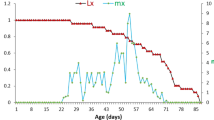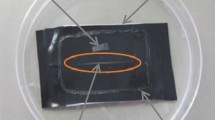Abstract
In the laboratory we examined the effect of pH (5–10 with one interval) on survival, reproduction, egg viability and growth rate (intrinsic growth rate—r m and population growth rate—r) of five Brachionus rotifer species (B. calyciflorus, B. quadridentatus, B. urceolaris, B. patulus and B. angularis). The pH was shown to exert a major influence on egg viability and growth rate (r m and r) for each species. The age-specific survivorship curves within a species were not significantly different at pH 6–10. The optimal pH for each species is near-neutral pH (pH 6–8), and the fecundity decreased as the pH deviated from these values. For each Brachionus species, there was no significant difference between age-specific fecundity curves at pH 7 and 8. At acid pH (pH 5 or 6) higher egg mortality was observed for each species. The r m and population r of the five Brachionus species incubated at different pHs were significantly influenced by pH. The pH supporting the highest r m or r was obtained at pH 6–8, but varied due to species. In this study B. urceolaris and B. patulus could tolerate a broad range of pH, while the populations of B. calyciflorus, B. quadridentatus and B. angulari declined at acid conditions.





Similar content being viewed by others
References
Ahlstrom EH (1940) A revision of the rotatorian genera Brachionus and Platyias with description of one new species and two varieties. Bull Am Mus Nat Hist 77:143–184
Alibone MR, Fair P (1981) The effets of low pH on the respiration of Daphnia magna Straus. Hydrobiologia 85:185–188
Bērziņš B, Pejler B (1987) Rotifer occurrence in relation to pH. Hydrobiologia 147:107–116
Brett M (1989) The rotifer communities of acid-stressed lakes of maine. Hydrobiologia 186/187:181–189
Chesson PL (1986) Environmental variation and the coexistence of species. In: Diamond J, Case TJ (eds) Community ecology. Harper & Row, New York, pp 240–256
Deneke R (2000) Review of rotifers and crustaceans in highly acidic environments of pH values ≤3. Hydrobiologia 433:167–172
FACHB–Collection (2005) Institute of hydrobiology, Chinese academy of sciences. http://algae.ihb.ac.cn/search/data/SE%20medium.htm#SEmedium.htm Cited 17 Feb 2007
Fischer JM, Frost TM (1997) Indirect effects of lake acidification on Chaoborus population dynamics: the role of food limitation and predation. Can J Fish Aquat Sci 54:637–646
Frost TM, Montz PK, Gonzalez MJ, Sanderson BL, Arnott SE (1998) Rotifer responses to increased acidity: long-term patterns during the experimental manipulation of Little Rock Lake. Hydrobiologia 387/388:141–152
Gilbert JJ (1963) Mictic female production in the rotifer Brachionus calyciflorus. J Exp Zool 153:113–123
Gonzalez MJ, Frost TM (1994) Comparisons of laboratory bioassays and a whole-lake experiment: rotifer responses to experimental acidification. Ecol Applica 4:69–80
Hessen DO, Faafeng BA, Andersen T (1995) Competition or niche segregation between Holopedium and Daphnia: empirical light on abiotic key parameters. Hydrobiologia 307:253–261
Horvath FJ, Hummon WD (1980) Influence of mine on planktonic rotifers. Ohio J Sci 80:104–107
Kiesecker J (1996) pH-Mediated predator-prey interactions between Ambystoma tigrinum and Pseudacris triseriata. Ecol Applica 6:1325–1331
Klug JL, Fischer JM, Ives AR, Dennis B (2000) Compensatory dynamics in planktonic community responses to pH perturbations. Ecology 81:387–398
Krebs CJ (1994) Ecology: the experimental analysis of distribution and abundance, 4th edn. Harper & Row, New York, pp 168–181
Kring RL, O’Brien WJ (1976) Accommodation of Daphnia pulex to altered pH conditions as measured by feeding rate. Limnol Oceanogr 21:313–315
Locke A (1991) Zooplankton responses to acidification: a review of laboratory bioassays. Wat Air Soil Pollut 60:135–148
Locke A, Sprules WG (2000) Effects of acidic pH and phytoplankton on survival and condition of Bosmina longirostris and Daphnia pulex. Hydrobiologia 437:187–196
McConathy JR, Stahl JB (1982) Rotifera in the plankton and among filamentous algal lumps in 16 acid strip-mine lakes. Trans Ill Acad Sci 75:85–90
Meyer JS, Ingersoll CG, McDonald LL, Boyce MS (1986) Estimating uncertainty in population growth rates: Jackknife versus Bootstrap techniques. Ecology 67:1156–1166
Mitchell SA (1992) The effect of pH on Brachionus calyciflorus Pallas (Rotifera). Hydrobiologia 245:87–93
Mitchell SA, Joubert JHB (1986) The effect of elevated pH on the survival and reproduction of Brachionus calyciflorus. Aquaculture 55:215–220
Myers FJ (1937) Rotifera from the Adirondack region of New York. Am Mus Novit 903:1–17
O’Brien WJ, deNoyelles F Jr (1972) Photosynthetically elevated pH as a factor in zooplankton mortality in nutrient enriched ponds. Ecology 53:605–614
Parsons JD (1968) The effects of acid strip-mine effluents on the ecology of a stream. Arch Hydrobiol 65:25–50
Pehek EL (1995) Competition, pH, and the ecology of larval Hyla andersonii. Ecology 76:1786–1793
Potts WTW, Fryer G (1979) The effects of pH and salt content on sodium balance in Daphnia magna and Acantholeberis curvirostris (Crustacea: Cladocera). J Comp Physiol 129:289–294
Price EE, Swift MC (1985) Intra- and inter-specific variability in the response of zooplankton to acid stress. Can J Fish Aquat Sci 42:1749–1754
Schoener TW (1983) Field experiments on interspecific competition. Am Nat 122:240–285
Sigee DC (2005) Freshwater microbiology: biodiversity and dynamic interactions of microorganisms in the aquatic environment. John Wiley & Sons, West Sussex, p 89
Sládeček V (1983) Rotifers as indicators of water quality. Hydrobiologia 100:169–201
Susan CW, Joseph T, William AD (1993) Effect of pH variation of interspecific competition between two species of Hylid tadpoles. Ecology 74:183–194
Vijverberg J, Kalf DF, Boersma M (1996) Decrease in Daphnia egg viability at elevated pH. Limnol Oceanogr 41:789–794
Wallace RL, Snell TW (2001) Rotifera. In: Thorp JH, Covich AP (eds) Ecology and classification of North American freshwater invertebrates, 2nd edn. Academic Press, New York, p 206
Wang JQ, Li DS, Luo YB, Wang F (1997) Influence of medium pH on population growth and reproduction of Brachionus calyciflorus. Chin J Appl Ecol 8:435–438
Wetzel RG (2001) Limnology: lake and river ecosystems, 3rd edn. Academic Press, New York
Xi YL, Huang XF (1999) Effect of pH on population dynamics and resting egg of Brachionus calyciflorus. J Fish Sci China 6:19–22
Acknowledgments
We thank four anonymous referees for constructive comments on the manuscript. We also thank X.X. Chen for technical assistance during the investigation. This study was supported by the National Natural Science Foundation of China (no. 30470309).
Author information
Authors and Affiliations
Corresponding author
Rights and permissions
About this article
Cite this article
Yin, X.W., Niu, C.J. Effect of pH on survival, reproduction, egg viability and growth rate of five closely related rotifer species. Aquat Ecol 42, 607–616 (2008). https://doi.org/10.1007/s10452-007-9136-9
Received:
Accepted:
Published:
Issue Date:
DOI: https://doi.org/10.1007/s10452-007-9136-9




